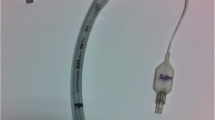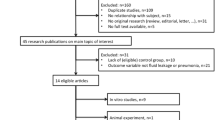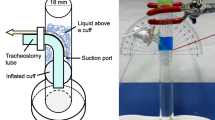Abstract
Purpose
Standard polyvinylchloride (PVC) endotracheal tube (ETT) cuffs do not protect from aspiration across the cuff, a leading cause of ventilator-associated pneumonia (VAP). In a long-lasting in vitro study we compared the effect of different cuff materials (PVC, polyurethane, and guayule latex), shapes (cylindrical, conical), and positive end expiratory pressures (PEEP) in reducing fluid leakage across the cuff.
Methods
We compared fluid leakage across a cylindrical double-layer guayule latex prototype cuff, three cylindrical PVC cuffs (Mallinckrodt Hi-Lo, Mallinckrodt HighContour, Portex Ivory), one conical PVC cuff (Mallinckrodt TaperGuard), and two polyurethane cuffs (Mallinckrodt SealGuard, conical; Microcuff, cylindrical). Ten centimeters of dyed water was poured above the cuffs inflated (pressure 30 cmH2O) in a vertical cylinder (diameter 20 mm). A respiratory circuit connected the bottom of the cylinder to a breathing bag inflated at four pressures (PEEP = 0, 5, 10, 15 cmH2O). Pictures were taken every 60 s for 24 h to measure leakage as a reduction in the water column above the cuff. Five new ETTs of each type were tested.
Results
The guayule latex cuffs showed no leakage at all the PEEP levels. Both the cylindrical and conical polyurethane cuffs showed limited leakage (2.1 ± 1.8 cm of water) only for PEEP zero. The PVC cuffs showed reduced leakage with increasing PEEP: 8.4 ± 1.5, 7.8 ± 2.2, 2.2 ± 1.0, and 0 cm of water at 0, 5, 10, and 15 cmH2O, respectively. Among all the PVC cuffs, the conical shape ensured higher sealing properties.
Conclusions
The guayule latex cuffs always prevented fluid leakage; the polyurethane and PVC cuffs required incremental levels of PEEP to prevent fluid leakage ever-present at zero PEEP.
Similar content being viewed by others
Avoid common mistakes on your manuscript.
Introduction
Endotracheal tube (ETT) with polyvinylchloride (PVC) high-volume low-pressure (HVLP) cuffs were introduced during the 1970s to reduce the incidence of tracheal mucosal damage due to high cuff pressure exerted against the tracheal wall while using the latex rubber cuffs [1]. When fully inflated, HVLP cuffs reach a diameter 1.5–2 times larger than an average trachea of an adult. Thus, HVLP cuffs inflated in the trachea always form folds and do not ensure a perfect sealing of the lower airways, predisposing the patient to microaspiration of bacteria colonized secretions from the subglottic space into the lower airways [2]. Such microaspiration represents one of the leading pathogenic pathways to tracheobronchial colonization and subsequent ventilator-associated pneumonia (VAP) [3]. Therefore several preventive strategies to decrease the incidence of VAP aim at blocking microaspiration by reducing the formation and dimension of ETT cuff folds, featuring ETTs with a very thin cuff made of polyurethane (PU). The use of a PU cuff reduced microaspiration in an in vitro test and, combined with continuous subglottic aspiration, which lowers the volume of fluid above the ETT cuff, led to a reduction in the incidence of early postoperative pneumonia after cardiac surgery. To further reduce microaspiration we recently designed and tested a prototype ETT cuff wrapping a standard PVC HVLP ETT cuff with a thin, high-compliance, low-protein guayule latex rubber cuff. This prototype requires low-inflation pressure to fill the trachea and forms no folds during inflation, therefore ensuring a perfect seal of the trachea and preventing fluid leakage across the cuff. Because microaspiration involves flow of fluids along the ETT fold from the subglottic space into the lower trachea, application of positive end expiratory pressure (PEEP) has been proved to decrease such fluid flow in vitro and in in vivo studies [4–6], and, recently, to reduce the incidence of VAP to some degree in nonhypoxemic patients [7].
In recent years several new ETT cuffs were developed in order to reduce microaspiration; however, to the best of our knowledge, an inclusive comparison between all available HVLP cuffs has not been performed. We therefore evaluated the sealing properties, at incremental PEEP levels, of cuffs made of different materials (polyvinylchloride, polyurethane, guayule latex) and shapes (cylindrical, conical) in a 24-h in vitro study.
Materials and methods
Double-layer prototype ETT
The prototype ETT was made by draping a guayule latex cylindrical cuff over the Mallinckrodt Hi-Lo (internal diameter (ID) 8 mm) polyvinylchloride (PVC) cuff [8]. Half a milliliter of sterile surgical gel (Luan, Molteni, Italy) was introduced between the two cuffs. The outer latex cuff was secured on both ends using silk ligatures.
Leakage test
We tested in vitro for fluid leakage across the cuff (to resemble in vivo microaspiration) of the double-layer prototype ETT (previously designed and manufactured by our group [8]) and of six commercially available ETTs: Mallinckrodt Hi-Lo (Mallinckrodt, NY); Mallinckrodt High-Contour; Mallinckrodt TaperGuard; Mallinckrodt SealGuard; Microcuff (Kimberly Clark, GA); Portex Ivory (Smiths Medical, UK). Cuff physical features are reported in Table 1.
A transparent, vertically positioned PVC cylinder (25-cm long, 20-mm internal diameter), see Fig. 1, was used as a model of an adult human trachea. All ETTs (ID 8 mm) were inflated within the cylinder at intracuff pressures of 30 cmH2O. Internal cuff pressure was kept constant throughout the study via a flow system connected to a water seal valve that provided continuous positive pressure into the pilot balloon. A respiratory circuit, with a water trap, connected the artificial trachea to an anesthesia breathing bag. The tested ETT was connected, through a T piece, to a gas flow (30 l/min) and to a water seal valve to inflate the anesthesia breathing bag to the chosen PEEP, simulating a continuous flow positive airway pressure (CPAP) system. Four levels of PEEP (0, 5, 10, 15 cmH2O) were randomly applied.
Water, dyed with methylene blue, was poured above the cuff to make a water column on top of the cuff of 10 cm (corresponding to a hydrostatic pressure of 10 cmH2O). Graph paper was positioned behind the water column to assist measurements.
A web camera was positioned on a tripod in front of the model trachea and was set to automatically take a picture every 60 s for 24 h.
Leakage was detected, by a blind observer, analyzing the pictures and measuring the vertical height of the water column.
Five new ETTs of each type were tested at PEEP 5, 10, and 15 while five new ETTs of each type were tested at PEEP zero.
Statistics
The sealing properties of the different ETT cuffs and the effect of PEEP, cuff material, and shape on fluid leakage at 24 h were analyzed by using a repeated measured ANOVA with the Tukey post hoc test. Data are reported as mean ± standard deviation.
Results
Figure 2 shows the residual vertical height of the water column above the tested ETT cuffs at incremental times with PEEP 0, 5, 10, and 15 cmH2O. The sealing performance of each cuff was expressed as the height of the fluid column above the cuff at incremental time interval. The double-layer prototype ETT cuff was the only one to show no water leakage at all the studied PEEP levels.
At time zero a water column of 10 cm was poured above the tested ETT cuffs. The graphics represent the average and standard deviation of the residual vertical height of the water column (cm) at incremental times with PEEP 0, 5, 10, and 15 cmH2O. Double-layer prototype: guayule latex, cylindrical; Microcuff, polyurethane, cylindrical; Mallinckrodt SealGuard, polyurethane, conical; Mallinckrodt TaperGuard, polyvinylchloride, conical; Mallinckrodt Hi-Lo, polyvinylchloride, cylindrical; Mallinckrodt High-Contour, polyvinylchloride, cylindrical; Portex Ivory, polyvinylchloride, cylindrical
Effect of PEEP
The effect of PEEP on fluid leakage across the cuff was significant (P < 0.0001). Fluid leakage decreased at incremental PEEP levels. No fluid leakage, across all the ETT cuffs tested, was observed only at PEEP 15 cmH2O.
Effect of material and shape
The material of the cuff had a highly significant effect (P < 0.0001). PVC cuff performances were worse than performances of guayule latex (P < 0.0001) and polyurethane (P < 0.0001), whereas guayule latex did not statistically differ from polyurethane (P = 0.071).
There was an overall effect of cuff shape (P < 0.001). Conical shaped cuffs ensured higher sealing properties than cylindrical shaped cuffs.
Comparison between cuffs
The tested ETT cuffs were significantly different (P < 0.0001) after the 24-h study period.
The double-layer guayule latex cuff was significantly different from all the PVC cuffs (P < 0.0001), whereas did not reach a statistical difference compared with the Microcuff (P = 0.13) and the SealGuard (P = 0.10).
The leakage across the two polyurethane cuffs (Microcuff and SealGuard) was significantly lower than the leakage across all the PVC cuffs (P < 0.001). No differences were recorded between Microcuff and SealGuard, P = 0.89.
The conical PVC cuff (Taperguard) showed higher sealing performances compared with all the other PVC cuffs (P < 0.001).
No differences were recorded among all the cylindrical PVC cuffs.
All the water poured above the cylindrical PVC cuffs with PEEP 0 cmH2O leaked through the cuff during the 24-h study period. All the water leaked within 56 ± 74, 15 ± 13, and 4 ± 1 min for the Mallinckrodt High-Contour, Mallinckrodt Hi-Lo, and Portex Ivory, respectively.
Discussion
In this bench-top study the major determinants in reducing leakage of fluid past the tracheal tube cuff were the material of the ETT cuffs and the presence of positive pressure in the respiratory system below the ETT cuff (mimicking the use of PEEP in intubated patients).
When PEEP equals zero, which was the worst condition tested in the present study, the ETT cuff material was critical in determining fluid leakage rate across the cuff: (1) the double-layer cuff, designed to prevent formation of folds upon inflation in the trachea, was the only one to completely prevent leakage up to 24 h. (2) Mallinckrodt SealGuard and Microcuff, both made of thin polyurethane, formed only small folds when inflated in the mock trachea, holding, after the 24 h study period, more than 70% of the poured water. The two ETT cuffs performed similarly; therefore, because the mainly difference between SealGuard and Microcuff is the cuff shape, conical versus cylindrical, we can speculate that among polyurethane cuffs, the shape does not significantly affect fluid leakage. (3) At PEEP zero all the water poured above the tested HVLP cylindrical PVC cuffs leaked past the cuff in a time interval ranging from 2 to 184 min. The conical PVC cuff Mallinckrodt TaperGuard showed performances in-between the two polyurethane cuffs and the widely used cylindrical PVC cuffs.
We can therefore speculate that among the PVC cuffs, which is the material that offers the poorer sealing performance, the cuff shape may significantly affect fluid leakage.
These results, consistent with published data [5], were expected because the HVLP PVC cuffs, when inflated in the trachea, invariably form multiple longitudinal folds, i.e., open passages for fluid leakage.
For PEEPs higher than zero, the double-layer and the polyurethane cuffs showed almost no fluid leakage, whereas the PVC cuffs showed some degree of leakage. Only when the applied PEEP was higher than the hydrostatic pressure of the water column above the PVC cuff, i.e., in the present study PEEP 15, was no leakage detected.
The application of PEEP always resulted in a protective factor against fluid leakage. When PEEP was applied to the double-layer guayule latex cuff, which was the only cuff to show no fluid leakage at PEEP zero, PEEP did not alter the sealing performance of the cuff. When PEEP was applied to a polyurethane cuff, even a PEEP level half the hydrostatic pressure of the water column above the cuff was effective to almost prevent fluid leakage.
These findings are consistent with the results showed by Lucangelo and co-workers. They placed 2 ml of dye blue saline on the top of 40 ETT cuffs (20 Mallinckrodt Hi-Lo, 20 Mallinckrodt SealGuard) inflated at 30 cmH2O in patients kept with 5 cmH2O of PEEP. Fiberoptic bronchoscopy was performed after 1 and 5 h to detect the possible presence of blue dye in the trachea. Thereafter, PEEP was removed and hourly bronchoscopies were performed for 7 h. When PEEP was present, aspiration was detected only in two patients with PVC cuffs. After PEEP removal, fluid leakage was immediately present below all the PVC cuffs; at the end of the experiment, polyurethane cuffs of three patients were still sealed.
This in vitro test does not attempt to simulate the complexity of the physiological conditions: the stiff cylindrical PVC trachea, the vertical position, and the dyed-water viscosity may all favor leakage across the cuff; nevertheless, this setting, which with some simplification could be used in every anesthesia department to form a proper opinion on the quality of a particular ETT, is the common in vitro method to test the efficacy of new ETT cuffs in preventing fluid leakage [9]. The cuff-sealing properties reported in several studies with these settings were recently confirmed in human studies. We believe that the present manuscript explores some aspects affecting the aspiration process and may clarify and support some prevention strategies which have already produced clinically relevant results. We did not study the silicone rubber ETT cuff (LoTrach, UK) developed by Young et al., which showed extremely good sealing properties, because it requires an inflating pressure higher than the one used in our report.
Hence we can foresee the benefits of the clinical use of an ETT cuff capable of completely preventing fluid leakage in the absence of PEEP, because PEEP loss frequently occurs in clinical practice.
References
Cooper JD, Grillo HC (1969) The evolution of tracheal injury due to ventilatory assistance through cuffed tubes: a pathologic study. Ann Surg 169:334–348
Seegobin RD, van Hasselt GL (1986) Aspiration beyond endotracheal cuffs. Can Anaesth Soc J 33:273–279
Valencia M, Torres A (2009) Ventilator-associated pneumonia. Curr Opin Crit Care 15:30–35
Janson BA, Poulton TJ (1986) Does PEEP reduce the incidence of aspiration around endotracheal tubes? Can Anaesth Soc J 33:157–161
Young PJ, Rollinson M, Downward G, Henderson S (1997) Leakage of fluid past the tracheal tube cuff in a benchtop model. Br J Anaesth 78:557–562
Lucangelo U, Zin WA, Antonaglia V, Petrucci L, Viviani M, Buscema G, Borelli M, Berlot G (2008) Effect of positive expiratory pressure and type of tracheal cuff on the incidence of aspiration in mechanically ventilated patients in an intensive care unit. Crit Care Med 36:409–413
Manzano F, Fernandez-Mondejar E, Colmenero M, Poyatos ME, Rivera R, Machado J, Catalan I, Artigas A (2008) Positive-end expiratory pressure reduces incidence of ventilator-associated pneumonia in nonhypoxemic patients. Crit Care Med 36:2225–2231
Zanella A, Cressoni M, Epp M, Stylianou M, Kolobow T (2008) A double-layer tracheal tube cuff designed to prevent leakage: a bench-top study. Intensive Care Med 34:1145–1149
Dave MH, Koepfer N, Madjdpour C, Frotzler A, Weiss M (2010) Tracheal fluid leakage in benchtop trials: comparison of static versus dynamic ventilation model with and without lubrication. J Anesth 24:247–252
Author information
Authors and Affiliations
Corresponding author
Rights and permissions
About this article
Cite this article
Zanella, A., Scaravilli, V., Isgrò, S. et al. Fluid leakage across tracheal tube cuff, effect of different cuff material, shape, and positive expiratory pressure: a bench-top study. Intensive Care Med 37, 343–347 (2011). https://doi.org/10.1007/s00134-010-2106-z
Received:
Accepted:
Published:
Issue Date:
DOI: https://doi.org/10.1007/s00134-010-2106-z






